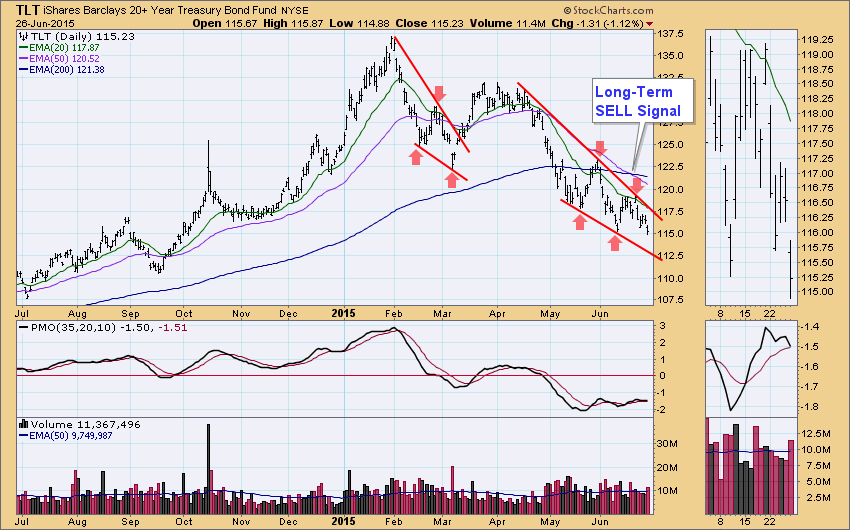
 The most important feature on the chart below is the fact that the 50EMA has crossed down through the 200EMA, generating a Long-Term Trend Model SELL signal for long bonds, and this tells us that bonds are in a bear market. In our analysis we use TLT as the ETF surrogate for long bonds. The purpose of this long-term SELL signal is not intended to encourage immediate short selling, but rather to alert investors to the fact that the environment for long bonds has turned bearish. In such an environment we can start looking for opportunities for short selling, but more important we need to recognize that bear market rules now apply to bonds. I don't actually have a set of rules written down, I just remind myself that the odds now favor bearish resolution of the various situations we might face. What do I mean by long-term? Nominally, I think of it as a period of months to years, but it can differ from one security to another. For TLT there have been about 13 long-term signal changes in the last 10 years.
The most important feature on the chart below is the fact that the 50EMA has crossed down through the 200EMA, generating a Long-Term Trend Model SELL signal for long bonds, and this tells us that bonds are in a bear market. In our analysis we use TLT as the ETF surrogate for long bonds. The purpose of this long-term SELL signal is not intended to encourage immediate short selling, but rather to alert investors to the fact that the environment for long bonds has turned bearish. In such an environment we can start looking for opportunities for short selling, but more important we need to recognize that bear market rules now apply to bonds. I don't actually have a set of rules written down, I just remind myself that the odds now favor bearish resolution of the various situations we might face. What do I mean by long-term? Nominally, I think of it as a period of months to years, but it can differ from one security to another. For TLT there have been about 13 long-term signal changes in the last 10 years.
As it so happens, the chart has some good examples of how patterns can resolve differently in bull and bear market conditions. One of my favorite chart patterns is the wedge (rising and falling) because it is very reliable in how it resolves. For now we'll just look at the falling wedge, of which there are two good examples on the chart. Falling wedges usually resolve upward and are considered to be bullish formations. This is because, of the two lines defining the top and bottom of the wedge, the top line is the steepest and the least likely to prevail.
On the chart we can see that the falling wedge that formed in February and March resolved upward, as expected, because bull market conditions were in effect. It also demonstrates that an upside breakout will not necessarily result in a change of trend. The expectation is that the wedge will resolve upward, and it is fulfilled once the breakout has taken place. In this case price eventually rolled over to resume a downward trend.
The second falling wedge formed in May and June. During that time price deteriorated and moved below all the EMAs, causing them to reverse into a bearish configuration (20EMA below the 50EMA, and 50EMA below the 200EMA). Notice the difference between the two wedges. In the first wedge price moved off the second bottom and promptly broke out of the top. In the current wedge price moved off the second bottom, but failed to break out of the top. Price is now headed down again, looking for a third bottom. And, given current bearish conditions, it is possible that price may break down through the bottom of the wedge. That is not a forecast, just recognition of the shift to a bearish market posture.
The PMO is negative and flat, which means that price is being subjected to steady downward pressure.
SUMMARY: The Long-Term Trend Model has switched from BUY to SELL, which tells us to expect bearish resolutions more often than not. The two falling wedge formations provide an excellent illustration of the effects of bull and bear market environments. The first wedge developed in the bull market conditions in February-March, and it had a snappy upside resolution, as was expected. The current wedge evolved as bonds were transitioning to a bear market, and rallies off of two price bottoms failed to resolve the pattern. We now have reason to believe that the wedge may resolve downward as the bear market unfolds.
Technical analysis is a windsock, not a crystal ball.







